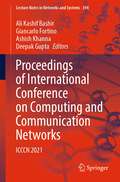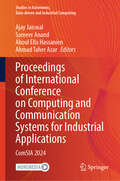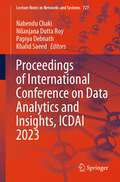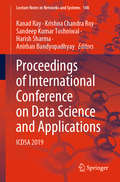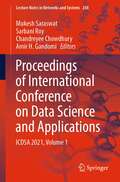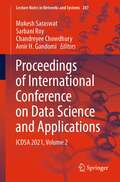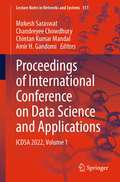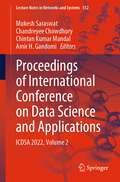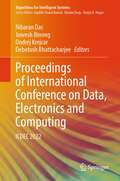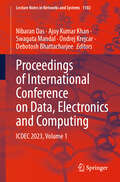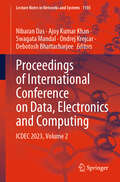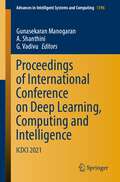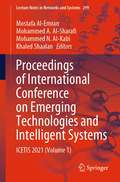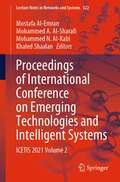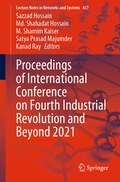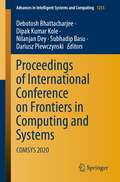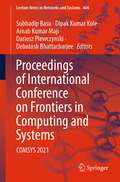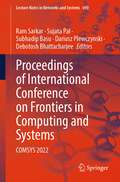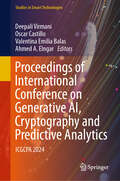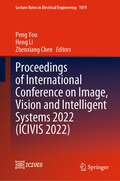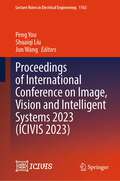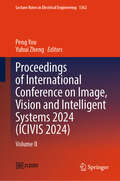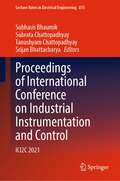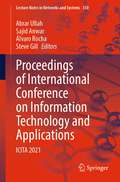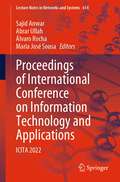- Table View
- List View
Proceedings of International Conference on Computing and Communication Networks: ICCCN 2021 (Lecture Notes in Networks and Systems #394)
by Giancarlo Fortino Deepak Gupta Ashish Khanna Ali Kashif BashirThis book includes selected peer-reviewed papers presented at the International Conference on Computing and Communication Networks (ICCCN 2021), held at Manchester Metropolitan University, United Kingdom, during 19–20 November 2021. The book covers topics of network and computing technologies, artificial intelligence and machine learning, security and privacy, communication systems, cyber physical systems, data analytics, cyber security for Industry 4.0, and smart and sustainable environmental systems.
Proceedings of International Conference on Computing and Communication Systems for Industrial Applications: ComSIA 2024 (Studies in Autonomic, Data-driven and Industrial Computing)
by Ahmad Taher Azar Aboul Ella Hassanien Sameer Anand Ajay JaiswalThe book is a collection of the high-quality research articles presented at International Conference on Computing and Communication Systems for Industrial Applications (ComSIA 2024), organized by Shaheed Rajguru College of Applied Sciences, University of Delhi, India during May 2024. The book covers state-of-the-art research articles from the researchers and practitioners working in the field of software engineering and automation, intelligent systems, data science and engineering, networks and data communication, internet of things, hardware architecture and communication technologies, cyber security and data privacy, and intelligent systems and automation.
Proceedings of International Conference on Data Analytics and Insights, ICDAI 2023 (Lecture Notes in Networks and Systems #727)
by Khalid Saeed Nabendu Chaki Nilanjana Dutta Roy Papiya DebnathThe book is a collection of peer-reviewed best selected research papers presented at the International Conference on Data Analytics and Insights (ICDAI 2023), organized by Techno International, Kolkata, India, during May 11–13, 2023. The book covers important topics like sensor and network data analytics and insights; big data analytics and insights; biological and biomedical data analysis and insights; optimization techniques, time series analysis and forecasting; power and energy systems data analytics and insights; civil and environmental data analytics and insights; and industry and applications.
Proceedings of International Conference on Data Science and Applications: ICDSA 2019 (Lecture Notes in Networks and Systems #148)
by Kanad Ray Anirban Bandyopadhyay Harish Sharma Krishna Chandra Roy Sandeep Kumar ToshniwalThis book gathers outstanding papers presented at the International Conference on Data Science and Applications (ICDSA 2019), held at Kautilya Institute of Technology and Engineering, Jaipur, Rajasthan, India, from 2 to 3 December 2019. It covers theoretical and empirical developments in various areas of big data analytics, big data technologies, decision tree learning, wireless communication, wireless sensor networking, bioinformatics and systems, artificial neural networks, deep learning, genetic algorithms, data mining, fuzzy logic, optimization algorithms, image processing, computational intelligence in civil engineering, creative computing, etc.
Proceedings of International Conference on Data Science and Applications: ICDSA 2021, Volume 1 (Lecture Notes in Networks and Systems #288)
by Amir H. Gandomi Sarbani Roy Mukesh Saraswat Chandreyee ChowdhuryThis book gathers outstanding papers presented at the International Conference on Data Science and Applications (ICDSA 2021), organized by Soft Computing Research Society (SCRS) and Jadavpur University, Kolkata, India, from April 10 to 11, 2021. It covers theoretical and empirical developments in various areas of big data analytics, big data technologies, decision tree learning, wireless communication, wireless sensor networking, bioinformatics and systems, artificial neural networks, deep learning, genetic algorithms, data mining, fuzzy logic, optimization algorithms, image processing, computational intelligence in civil engineering, and creative computing.
Proceedings of International Conference on Data Science and Applications: ICDSA 2021, Volume 2 (Lecture Notes in Networks and Systems #287)
by Amir H. Gandomi Sarbani Roy Mukesh Saraswat Chandreyee ChowdhuryThis book gathers outstanding papers presented at the International Conference on Data Science and Applications (ICDSA 2021), organized by Soft Computing Research Society (SCRS) and Jadavpur University, Kolkata, India, from April 10 to 11, 2021. It covers theoretical and empirical developments in various areas of big data analytics, big data technologies, decision tree learning, wireless communication, wireless sensor networking, bioinformatics and systems, artificial neural networks, deep learning, genetic algorithms, data mining, fuzzy logic, optimization algorithms, image processing, computational intelligence in civil engineering, and creative computing.
Proceedings of International Conference on Data Science and Applications: ICDSA 2022, Volume 1 (Lecture Notes in Networks and Systems #551)
by Amir H. Gandomi Mukesh Saraswat Chandreyee Chowdhury Chintan Kumar MandalThis book gathers outstanding papers presented at the International Conference on Data Science and Applications (ICDSA 2022), organized by Soft Computing Research Society (SCRS) and Jadavpur University, Kolkata, India, from 26 to 27 March 2022. It covers theoretical and empirical developments in various areas of big data analytics, big data technologies, decision tree learning, wireless communication, wireless sensor networking, bioinformatics and systems, artificial neural networks, deep learning, genetic algorithms, data mining, fuzzy logic, optimization algorithms, image processing, computational intelligence in civil engineering, and creative computing.
Proceedings of International Conference on Data Science and Applications: ICDSA 2022, Volume 2 (Lecture Notes in Networks and Systems #552)
by Amir H. Gandomi Mukesh Saraswat Chandreyee Chowdhury Chintan Kumar MandalThis book gathers outstanding papers presented at the International Conference on Data Science and Applications (ICDSA 2022), organized by Soft Computing Research Society (SCRS) and Jadavpur University, Kolkata, India, from 26 to 27 March 2022. It covers theoretical and empirical developments in various areas of big data analytics, big data technologies, decision tree learning, wireless communication, wireless sensor networking, bioinformatics and systems, artificial neural networks, deep learning, genetic algorithms, data mining, fuzzy logic, optimization algorithms, image processing, computational intelligence in civil engineering, and creative computing.
Proceedings of International Conference on Data, Electronics and Computing: ICDEC 2022 (Algorithms for Intelligent Systems)
by Nibaran Das Debotosh Bhattacharjee Juwesh Binong Ondrej KrejcarThis book features high-quality, peer-reviewed research papers presented at the International Conference on Data Electronics and Computing (ICDEC 2022) organized by departments of Electronics and Communication Engineering, Computer Applications, and Biomedical Engineering, North-Eastern Hill University, Shillong, Meghalaya, India during 7 – 9 September, 2022. The book covers topics in communication, networking and security, image, video and signal processing; cloud computing, IoT and smart city, AI/ML, big data and data mining, VLSI design, antenna, and microwave and control.
Proceedings of International Conference on Data, Electronics and Computing: ICDEC 2023, Volume 1 (Lecture Notes in Networks and Systems #1102)
by Nibaran Das Debotosh Bhattacharjee Ondrej Krejcar Ajoy Kumar Khan Swagata MandalThis book features high-quality, peer-reviewed research papers presented at the International Conference on Data Electronics and Computing (ICDEC 2023) organized by Department of Computer Science & Engineering, Mizoram University (A Central University) Aizawl, India & Department of Computer Science & Engineering, National Institute of Technology Mizoram Aizawl, India during 15 – 16 December 2023. The book covers topics in communication, networking and security, image, video and signal processing; cloud computing, IoT and smart city, AI/ML, big data and data mining, VLSI design, antenna, and microwave and control.
Proceedings of International Conference on Data, Electronics and Computing: ICDEC 2023, Volume 2 (Lecture Notes in Networks and Systems #1103)
by Nibaran Das Debotosh Bhattacharjee Ondrej Krejcar Ajoy Kumar Khan Swagata MandalThis book features high-quality, peer-reviewed research papers presented at the International Conference on Data Electronics and Computing (ICDEC 2023) organized by Department of Computer Science & Engineering, Mizoram University (A Central University) Aizawl, India & Department of Computer Science & Engineering, National Institute of Technology Mizoram Aizawl, India during 15 – 16 December 2023. The book covers topics in communication, networking and security, image, video and signal processing; cloud computing, IoT and smart city, AI/ML, big data and data mining, VLSI design, antenna, and microwave andcontrol.
Proceedings of International Conference on Deep Learning, Computing and Intelligence: ICDCI 2021 (Advances in Intelligent Systems and Computing #1396)
by G. Vadivu Gunasekaran Manogaran A. ShanthiniThis book gathers selected papers presented at the International Conference on Deep Learning, Computing and Intelligence (ICDCI 2021), organized by Department of Information Technology, SRM Institute of Science and Technology, Chennai, India, during January 7–8, 2021. The conference is sponsored by Scheme for Promotion of Academic and Research Collaboration (SPARC) in association with University of California, UC Davis and SRM Institute of Science and Technology. The book presents original research in the field of deep learning algorithms and medical imaging systems, focusing to address issues and developments in recent approaches, algorithms, mechanisms, and developments in medical imaging.
Proceedings of International Conference on Emerging Technologies and Intelligent Systems: ICETIS 2021 (Volume 1) (Lecture Notes in Networks and Systems #299)
by Khaled Shaalan Mostafa Al-Emran Mohammed A. Al-Sharafi Mohammed N. Al-KabiThis book sheds light on the emerging research trends in intelligent systems and their applications. It mainly focuses on three different themes, including software engineering, ICT in education, and management information systems. Each chapter contributes to the aforementioned themes by discussing the recent design, developments, and modifications of intelligent systems and their applications.
Proceedings of International Conference on Emerging Technologies and Intelligent Systems: ICETIS 2021 Volume 2 (Lecture Notes in Networks and Systems #322)
by Khaled Shaalan Mostafa Al-Emran Mohammed A. Al-Sharafi Mohammed N. Al-KabiThis book sheds light on the emerging research trends in intelligent systems and their applications. It mainly focuses on four different themes, including Artificial Intelligence and Soft Computing, Information Security and Networking, Medical Informatics, and Advances in Information Systems. Each chapter contributes to the aforementioned themes by discussing the recent design, developments, and modifications of intelligent systems and their applications.
Proceedings of International Conference on Fourth Industrial Revolution and Beyond 2021 (Lecture Notes in Networks and Systems #437)
by Kanad Ray M. Shamim Kaiser Sazzad Hossain Md. Shahadat Hossain Satya Prasad MajumderThis book includes papers in the research area of artificial intelligence, robotics and automation, IoT smart agriculture, data analysis and cloud computing, communication and technology, and signal and natural language processing. The book is a collection of research papers presented at the First International Conference on Fourth Industrial Revolution and Beyond (IC4IR 2021) organized by University Grants Commission of Bangladesh in association with IEEE Computer Society Bangladesh Chapter and Bangladesh Computer Society during December 10–11, 2021.
Proceedings of International Conference on Frontiers in Computing and Systems: COMSYS 2020 (Advances in Intelligent Systems and Computing #1255)
by Subhadip Basu Nilanjan Dey Debotosh Bhattacharjee Dipak Kumar Kole Dariusz PlewczynskiThis book gathers outstanding research papers presented at the International Conference on Frontiers in Computing and Systems (COMSYS 2020), held on January 13–15, 2019 at Jalpaiguri Government Engineering College, West Bengal, India and jointly organized by the Department of Computer Science & Engineering and Department of Electronics & Communication Engineering. The book presents the latest research and results in various fields of machine learning, computational intelligence, VLSI, networks and systems, computational biology, and security, making it a rich source of reference material for academia and industry alike.
Proceedings of International Conference on Frontiers in Computing and Systems: COMSYS 2021 (Lecture Notes in Networks and Systems #404)
by Subhadip Basu Arnab Kumar Maji Debotosh Bhattacharjee Dipak Kumar Kole Dariusz PlewczynskiThis book gathers outstanding research papers presented at the 2nd International Conference on Frontiers in Computing and Systems (COMSYS 2021), organized by Department of Electronics and Communication Engineering and Department of Information Technology, North-Eastern Hill University, Shillong, Meghalaya, India held during September 29–October 1, 2021. The book presents the latest research and results in various fields of machine learning, computational intelligence, VLSI, networks and systems, computational biology, and security, making it a rich source of reference material for academia and industry alike.
Proceedings of International Conference on Frontiers in Computing and Systems: COMSYS 2022 (Lecture Notes in Networks and Systems #690)
by Sujata Pal Subhadip Basu Debotosh Bhattacharjee Dariusz Plewczynski Ram SarkarThis book gathers high-quality research papers presented at the 3rd International Conference on Frontiers in Computing and Systems (COMSYS 2022) held at Indian Institute of Technology Ropar, Punjab, India, during December 19–21, 2022. The book covers research in “cyber-physical systems for real-life applications” pertaining to AI, machine learning, and data science; devices, circuits, and systems; computational biology, biomedical informatics and network medicine; communication networks, cloud computing and IoT; image, video and signal processing; and security and privacy.
Proceedings of International Conference on Generative AI, Cryptography and Predictive Analytics: ICGCPA 2024 (Studies in Smart Technologies)
by Oscar Castillo Valentina Emilia Balas Ahmed A. Elngar Deepali VirmaniThe book presents the proceedings of the International Conference on Generative AI, Cryptography and Predictive Analytics (ICGCPA 2024), held at VIPS-TC, School of Engineering and Technology, Pitampura, Delhi, India, during June 28 – 29, 2024. It covers Generative AI's role in problem-solving, examining applications in image synthesis, content creation, healthcare, and optimization challenges. This book is a valuable resource for postgraduate students in various engineering disciplines.
Proceedings of International Conference on Image, Vision and Intelligent Systems 2022 (Lecture Notes in Electrical Engineering #1019)
by Heng Li Peng You Zhenxiang ChenThis book is a collection of the papers accepted by the ICIVIS 2022—The International Conference on Image, Vision and Intelligent Systems, held on August 15–17, 2022, in Jinan, China. The topics focus but are not limited to image, vision and intelligent systems. Each part can be used as an excellent reference by industry practitioners, university faculties, research fellows and undergraduates as well as graduate students who need to build a knowledge base of the most current advances and state of practice in the topics covered by this conference proceedings.
Proceedings of International Conference on Image, Vision and Intelligent Systems 2023 (Lecture Notes in Electrical Engineering #1163)
by Jun Wang Peng You Shuaiqi LiuThis book constitutes the refereed proceedings of ICIVIS2023, held in Baoding, China, in August 2023. The papers included in the proceedings have been carefully reviewed and selected from the submitted manuscripts in the areas of image, vision and intelligent systems. This book provides a reference for theoretical innovative problems as well as recent practical solutions and applications for the state-of-the-art results in image, vision and intelligent systems. The intended audience of the book includes researchers, professors, experts, practitioners and professionals in the field of image, vision and intelligent systems worldwide.
Proceedings of International Conference on Image, Vision and Intelligent Systems 2024: Volume II (Lecture Notes in Electrical Engineering #1362)
by Peng You Yuhui ZhengThis book constitutes the refereed proceedings of ICIVIS2024, held in Xining, China, in June 2024. This book provides a comprehensive collection of cutting-edge research and innovative solutions in image, vision and intelligent systems. The primary audience consists of academic researchers, industry professionals, and graduate students working in the domains of image, vision, and intelligent systems. This publication serves as an essential resource for those seeking to stay at the forefront of their respective fields, expand their knowledge, and explore new avenues for research and development.
Proceedings of International Conference on Industrial Instrumentation and Control: ICI2C 2021 (Lecture Notes in Electrical Engineering #815)
by Subhasis Bhaumik Subrata Chattopadhyay Tanushyam Chattopadhyay Srijan BhattacharyaThis book is a collection of selected high-quality research papers presented at the International Conference on Industrial Instrumentation and Control (ICI2C 2021), organized by the Department of Applied Electronics & Instrumentation Engineering, RCC Institute of Information Technology, Kolkata, India, during 20–August 22, 2021. It includes novel and innovative work from experts, practitioners, scientists and decision-makers from academia and industry. It covers topics such as instrumentation application in industry, instrumentation in electrical applications and instrumentation in recent trends with computation approach.
Proceedings of International Conference on Information Technology and Applications: ICITA 2021 (Lecture Notes in Networks and Systems #350)
by Álvaro Rocha Sajid Anwar Abrar Ullah Steve GillThis book includes high-quality papers presented at 15th International Conference on Information Technology and Applications (ICITA 2021), held in Dubai, UAE during 13 – 14 November 2021. The book presents original research work of academics and industry professionals to exchange their knowledge of the state-of-the-art research and development in information technology and applications. The topics covered in the book are cloud computing, business process engineering, machine learning, evolutionary computing, big data analytics, internet of things and cyber-physical systems, information and knowledge management, computer vision and image processing, computer graphics and games programming, mobile computing, ontology engineering, software and systems modelling, human computer interaction, online learning / e-learning, computer networks, and web engineering.
Proceedings of International Conference on Information Technology and Applications: ICITA 2022 (Lecture Notes in Networks and Systems #614)
by Álvaro Rocha Sajid Anwar Abrar Ullah Maria José SousaThis book includes high-quality papers presented at 16th International Conference on Information Technology and Applications (ICITA 2022), held in Lisbon, Portugal during October 20–22, 2022. The book presents original research work of academics and industry professionals to exchange their knowledge of the state-of-the-art research and development in information technology and applications. The topics covered in the book are cloud computing, business process engineering, machine learning, evolutionary computing, big data analytics, Internet of things and cyber-physical systems, information and knowledge management, computer vision and image processing, computer graphics and games programming, mobile computing, ontology engineering, software and systems modeling, human–computer interaction, online learning / e-learning, computer networks, and web engineering.
